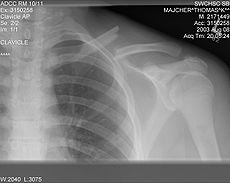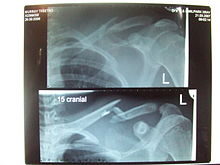- Clavicle fracture
-
Clavicle fracture Classification and external resources 
X-ray of a left clavicle fractureICD-10 S42.0 ICD-9 810 MedlinePlus 001588 eMedicine orthoped/50 A clavicle fracture is a bone fracture in the clavicle, or collarbone. It is often caused by a fall onto an outstretched upper extremity, a fall onto a shoulder, or a direct blow to the clavicle. Many research projects are underway regarding the medical healing process of clavicle fractures.
Contents
Signs and symptoms
- Pain, particularly with upper extremity movement
- Swelling
- Often, after the swelling has subsided, the fracture can be felt through the skin.
- Sharp pain when any movement is made.
- Referred pain: dull to extreme ache in and around clavicle area, including surrounding muscles.
- Possible nausea, dizziness, and/or spotty vision due to extreme pain
Diagnosis
X rays are the standard method of diagnosis however ultrasound imaging performed in the emergency room may be equally accurate in children.[1]
Treatment
Nonoperative
Treatment usually involves resting the affected extremity and supporting the arm with the use of a sling.
In older practice, a figure-8 brace was used, designed to immobilize and retract the shoulder, maintaining symmetric positioning to facilitate healing. More recent clinical studies have shown that the outcomes of this method were not measurably different from simple sling support[citation needed], and due to the movement difficulties caused to the patient, this method has mostly lapsed[citation needed].
Current practice is generally to provide a sling, and pain relief, and to allow the bone to heal itself, monitoring progress with X-rays every week or few weeks. Surgery is employed in 5-10% of cases. However, a recent study supports primary plate fixation of completely displaced midshaft clavicular fractures in active adult patients[2].
More than 90% of clavicle fractures are successfully healed by non-operative treatment.[citation needed]
If the fracture is at the lateral end, the risk of nonunion is greater than if the fracture was of the shaft.[3]
Surgical
The surgery is indicated when one or more of the following conditions presents.
- Comminution with separation (multiple piece)
- Significant Foreshortening of the clavicle (indicated by shoulder forward).
- Skin penetration (Open Fracture).
- Clearly associated nervous and vascular trauma (Brachial Plexus or Supra Clavicular Nerves).
- Non Union after several months (3–6 months, typically)
- Distal Third Fractures which interfere with normal function of the ACJ (Acriomio Clavicular Joint).
A discontinuity in the bone shape often results from a clavicular fracture, visible through the skin, if not treated with surgery. Surgical procedure will often call for ORIF (Open Reduction Internal [plate] Fixation) where an anatomically shaped titanium or steel plate is affixed along the superior aspect of the bone via several screws. In some cases the plate may be removed after healing, but this is very rarely required (based on nerve interaction or tissue aggavation), and typically considered an elective procedure. Alternatively, intramedullary fixation devices (within the medullary canal) can be implanted to support the fracture during healing. These devices are implanted within the clavicle's canal to support the bone from the inside. Typical surgical complications are infection, neurological symptoms distal the incision (sometimes to the extremity), and non-union.
Prognosis
Healing time varies based on age, health, complexity and location of the break as well as the bone displacement. For adults, a minimum of 3–4 weeks of sling immobilization is normally employed to allow initial bone and soft tissue healing, teenagers require slightly less, children can often achieve the same level in two weeks. During this period, patients may remove the sling to practice passive pendulum Range of Motion (ROM) exercises to reduce atrophy in the elbow and shoulder, but they are minimized to 15-20 degrees off vertical.
The immobilization is followed by a theraputic regimen of passive exercises, and later of active exercises. Full radiological union is typically achieved in 16 weeks for adult surgical patients, and shorter times are achieved by teenagers and young children. In patients who participated in prescribed physical therapy, 85-100% mobility returned in 6–9 months, with full strength returning in 9–12 months.
More details can be found in the following studies:
http://www.ejbjs.org/cgi/content/full/89/1/1
http://www.ejbjs.org/cgi/content/full/91/2/447
http://www.ejbjs.org/cgi/content/abstract/90/Supplement_2__Part_1/1
http://www.jaaos.org/cgi/content/abstract/15/4/239Epidemiology
Clavicle fractures involve approximately 5% of all fractures seen in hospital emergency admissions[citation needed]. Clavicles are the most common broken bone in the human body[4]. It is most often fractured in the middle third of its length which is its weakest point. The lateral fragment is depressed by the weight of the arm and is pulled medially and forward by the strong adductor muscles of the shoulder joint, especially the pectoralis major. The part of the clavicle near the center of the body is tilted upwards by the sternocleidomastoid muscle. Children and infants are particularly prone to it. Newborns often present clavicle fractures following a difficult delivery.
After fracture of the clavicle, the sternocleidomastoid muscle elevates the medial fragment of the bone. The trapezius muscle is unable to hold up the distal fragment owing to the weight of the upper limb, and thus the shoulder droops. The adductor muscles of the arm, such as the pectoralis major, may pull the distal fragment medially causing the bone fragments to override.
History
Hippocrates, 4th century BC:
- When, then, a [clavicle] fracture has recently taken place, the patients attach much importance to it, as supposing the mischief greater than it really is, and the physicians bestow great pains in order that it may be properly bandaged; but in a little time the patients, having no pain, nor finding any impediment to their walking or eating, become negligent; and the physicians finding they cannot make the parts look well, take themselves off, and are not sorry at the neglect of the patient, and in the meantime the callus is quickly formed. [1]
The management of skeletal injuries in ancient Egypt – Collar bone:
- If thou examinest a man having a break in his collar bone and shouldst thou find his collar bone short and separated from its fellow, I will treat. Place him prostrate on his back with something folded between his shoulder blades; thou shouldst spread out with his two shoulders to stretch apart his collar bone until the break falls in its place. [2]
See also
References
- ^ PMID 20653581
- ^ Nonoperative Treatment Compared with Plate Fixation of Displaced Midshaft Clavicular Fractures - http://www.ejbjs.org/cgi/content/abstract/89/1/1
- ^ Khan LA, Bradnock TJ, Scott C, Robinson CM (February 2009). "Fractures of the clavicle". J Bone Joint Surg Am 91 (2): 447–60. doi:10.2106/JBJS.H.00034. PMID 19181992. http://www.ejbjs.org/cgi/pmidlookup?view=long&pmid=19181992.
- ^ Richard S. Snell, MD, PHD (2010-03-10). "Chapter 9: The upper Limb". Clinical Anatomy by Regions (8th ed.). Lippincott Williams & Wilkins. p. 433. ISBN 978-0-7817-6404-9.
External links
- /clavicle-immobilization.info Elastic wrapping method
Injury : Fractures and cartilage injuries (Sx2, 800–829) General Head Vertebral Spinal fractureRibs Shoulder, arm
and handShoulderArmHandHip, leg and foot Hip/femurLegFootCategories:- Bone fractures
- Injuries of shoulder and upper arm
Wikimedia Foundation. 2010.





